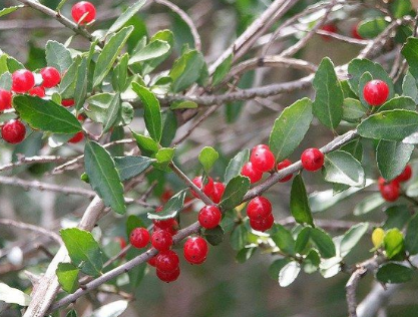Yaupon, Ilex vomitoria
This native holly is a broadleaf evergreen shrub or small tree indigenous to the coastal plains and maritime forests from Virginia to Florida. It can reach up to 20’ tall and 12’ wide. Inconspicuous flowers appear in the spring on separate male and female plants with the females producing red berries that last through the winter.

Plant Yaupon in average, well-drained soil in sun to partial shade. This native plant can withstand both drought and occasional flooding and is resistant to deer, salt, and wind. It supports native wildlife including butterflies, pollinators, small animals, songbirds, and bees. Growing rapidly, it makes a good privacy screen, hedge, or windbreak. It has no insect or disease problems.
The leaves and stems can be dried and brewed to make a caffeinated tea and was used by native American Indians in a cleansing ceremony. They would drink it in such large quantities that it would make them vomit, cleaning out their systems. Thus, the botanical name “vomitoria.”
This is a common plant in the nursery industry and is, therefore, readily available at the garden center. It has a tendency to form thickets, so suckers should be removed to maintain a desirable growth habit and, if desired, it will also take heavy pruning.
Virginia Cooperative Extension programs and employment are open to all, regardless of age, color, disability, gender, gender identity, gender expression, national origin, political affiliation, race, religion, sexual orientation, genetic information, veteran status, or any other basis protected by law. An equal opportunity/affirmative action employer. Issued in furtherance of Cooperative Extension work, Virginia Polytechnic Institute and State University, Virginia State University, and the U.S. Department of Agriculture cooperating. Edwin J. Jones, Director, Virginia Cooperative Extension, Virginia Tech, Blacksburg; M. Ray McKinnie, Administrator, 1890 Extension Program, Virginia State University, Petersburg.
